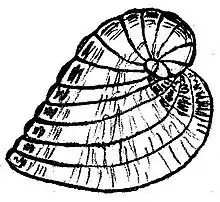| Soritoidea | |
|---|---|
 | |
| Illustration of Peneroplis planatus | |
| Scientific classification | |
| Domain: | |
| (unranked): | |
| (unranked): | |
| Superphylum: | |
| Phylum: | |
| Class: | |
| Order: | |
| Superfamily: | Soritoidea Ehrenberg 1839 |
| Families | |
| |
The Soritoidea is a group of miliolid benthic foraminifera with porcellaneous tests. They take on a variety of growth forms but typically have many chambers. Some soritids can grow over a centimeter across, huge for protists. All Soritoidea keep algal endosymbionts, which may be what allows them to achieve such large sizes. Some species have red algal symbionts, some have green algal symbionts, and others have dinoflagellate symbionts. These larger symbiont-bearing foraminifera are typically found in the oligotrophic waters of the tropics.
The species Marginopora vertebralis occupies similar habitats to reef-building corals and may have an ecological relationship with the corals, serving as an alternate host to the zooxanthellae, which sometimes get expelled by the corals under stressful conditions.[2]
References
- ↑ "Soritoidea". WoRMS. World Register of Marine Species. Retrieved 2018-12-04.
- ↑ Ross, Charles A. (1972). "Biology and Ecology of Marginopora vertebralis (Foraminiferida), Great Barrier Reef". The Journal of Protozoology. 19 (1): 181–192. doi:10.1111/j.1550-7408.1972.tb03433.x.
- Gudmundsson, G. (1994). "Phylogeny, ontogeny, and systematics of Recent Soritacea Ehrenberg 1839 (Foraminiferida)". Micropaleontology. 40 (2): 101–155. doi:10.2307/1485772. JSTOR 1485772.